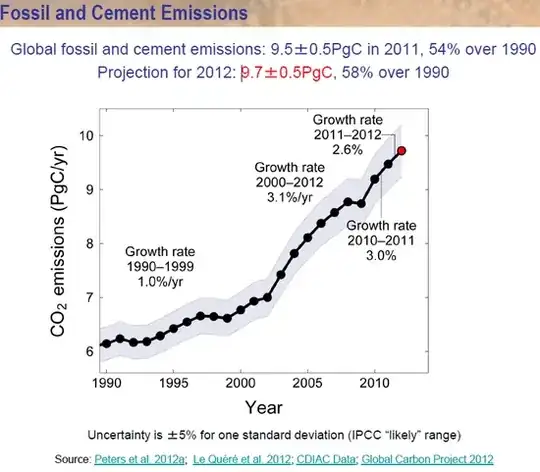According to TRENDS IN GLOBAL CO2 EMISSIONS 2014 Report
Global carbon dioxide (CO2) emissions from fossil fuel combustion and from industrial processes (cement and metal production) increased in 2013 to the new record of 35.3 billion tonnes (Gt) CO2, which is 0.7 Gt higher than last year’s record. This moderate increase of 2% in 2013 compared to 2012 is a continuation of last year’s trend and of the slowdown in the annual emissions growth. The actual increase of 2012 compared to 2011 was 0.6 Gt or 1.7% (excluding leap year correction) and both are about half the average annual growth rate of 1.1 Gt or 3.8% since 2003 (excluding the 2008–2009 recession years). Note that the average annual emission increase in the 1995–2002 period (after the large decline in energy consumption in the former Soviet Union countries) was about 1.2% or 0.4 Gt CO2 per year. With the global economic growth of 3.4% and 3.1%, in 2012 and 2013 respectively, a further decoupling of the global economic and emission trends can be observed. This decoupling is consistent with the increasing service sector share (growing by 1.5% and 1.8% in 2012 and 2013 on average in middle income countries, including China) to the overall gross domestic product, at the expense of more energy-intensive industrial activities.
See also Global growth in CO2 emissions plateaus
After a decade of rapid growth in global CO2 emissions, which increased at an average annual rate of 4%, much smaller increases were registered in 2012 (0.8%), 2013 (1.5%) and 2014 (0.5%).
Also, from Global Carbon Budget 2012

See also Reaching peak emissions Nature Climate Change volume 6, pages 7-10, which projects that CO2 emissions actually decreased 0.6% from 2014 to 2015.
So 6% rate of growth is not representative of what is happening currently.
However, according to Figure 4.1 of Reducing CO2 Emissions: A Comparative Input-Output-Study for Germany and the UK, world CO2 emissions reached a peak year over year percent increase of about 5.5 in 1967. So if you look at her exact wording, "since the start of the industrial revolution...as much as six percent annually", what she is saying might confuse some, but it is true.
Alternatively, looking at the concentration of CO2 in the air, it is currently 402 ppm, increasing at a rate of about 2-3ppm per year, or 0.5% to 0.8% per year.
